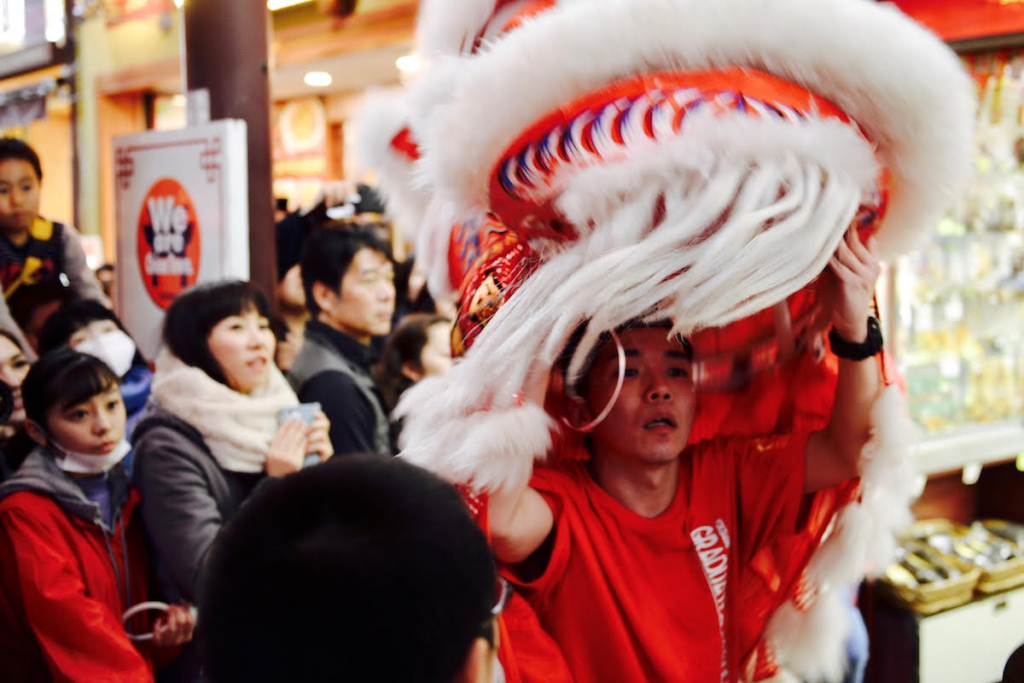This year, Chinese New Year fell on January 28, and there is no better place to celebrate the event than at Chinatown in Yokohama.
Words and images by Stack Jones
The weather was perfect. The wind was light, and the sky was clear. Hopefully, this was a sign that a good year is on its way. Exiting at Ishikawacho Station, I could already hear the beating of the drums and the crackling of fireworks, and sense the excitement that was not too far off.
After a great meal of black rice and gyoza, it was time to stroll around Chinatown to catch the action. As I entered the main gate, there was a large crowd gathered, with all manner of cellphones and cameras clicking away. A burst of firecrackers drowned out the beating of the drums, then suddenly a large dragon head leaped up and towered high above the crowd that encircled it. The dragon then swiftly turned, as something had caught its attention. A young boy, sitting on his father’s shoulders. The silent drums began to beat again and the dragon wildly leaped toward the boy and devoured him up. Yep, I was certainly in Chinatown!


I tried to edge my way to the front of the crowd, but it was too late. The entourage was already making its way to the next building where throngs of people on the second and third floors dangled out windows, vying for the best position from which to view the spectacle before them. I had to back out of the way as a group of teenagers, all clad in red, ushered the drenched dragon dancers to a nearby shop doorway. The shop owner appeared at the door, snapping photos as the counter worker giggled, trying to hide her face. The dragon wiggled forward, and soon enough, the drums were beating again.


The dragon and lion dances have been an integral part of Chinese festivities for centuries. As the Chinese migrated from continent to continent, they brought along with them their treasured past. The dragon dance is one of those treasures, and has become a recognizable symbol of Chinese culture. But, what does it symbolize? To answer that question, one must understand that the dragon dance is accompanied by the lion dance, which also originated from China’s ancient past.
The dragon dance, which dates back to the Han dynasty some 2,200 years ago, is said to symbolize wisdom, power and wealth. It is also said to bring good luck to people who bear witness to it. The dance was originally used in ancestor worship ceremonies as well as to pray for rain for agricultural purposes. Over time, it developed into the entertainment form which is popular in today’s culture. By the Tang and Song dynasties, the dragon dance had become a well-established ceremonial activity in festivals, and eventually became part of the Chinese New Year.
The dragon body used in the dance is often placed in a Dragon King Temple. It may only be removed from the temple by locals, accompanied by the familiar pounding of drums, and the blowing of trumpets. The head and the tail of the dragon are connected to the body, and a ceremony known as eye-pointing ensues. The dragon goes where it will, and is welcomed everywhere it goes.


At the end of the New Year celebrations, the dragon’s head and tail are burnt as an offering, while the body is returned to the temple, where it will remain until the following year.
Just as the dragon dance is used for festivity purposes in Chinese culture, so too is the lion dance. The northern lion dance was originally created as entertainment for the Imperial court. The northern lion is usually red, orange, and yellow in appearance, and often has green fur (to depict a female lion, which will also have a shaggy appearance and even a gold colored head). The northern dance is more acrobatic than the southern lion dance, and is performed solely for entertainment purposes.
The southern lion dance is symbolic in nature. Originating in Canton, this dance is performed as a ceremony to ward off evil spirits, and to summon good luck and fortune. The southern lion is distinct from the northern lion as it is created with a wide variety of colors and has large eyes, a mirror on its forehead, and a single horn not unlike a unicorn’s. Both lion dances have become an integral part of Chinese New Year.


The lion dance is often confused with the dragon dance, but the main difference is in numbers: the dragon dance can feature upwards of ten or more dancers, while the lion dance consists of only a pair of dancers.
Fat San is the style of lion dance used by many kung fu schools for their performances. It requires great expertise, and is only performed by the most talented martial artists who train at the schools. The Hok San style is a contemporary form of dancing. This style combines a southern lion head with the northern lion dance. The Hok Shan style attempts to replicate a life-like mannerism. To achieve this, the performers create a shorter tail for the lion body to aid mastering pole jumping.
The different colors used in the creation of the lions are related to the age, wisdom and movement ability of the lion: a white lion is the oldest, a golden lion is a middle child, and a black one is the youngest. The youngest lion moves the quickest during the lion dance, and has more agility than the older ones.
Now you know all there is to know about the dragon and lion dances, all that’s left to say is here’s to the Year of the Rooster!











